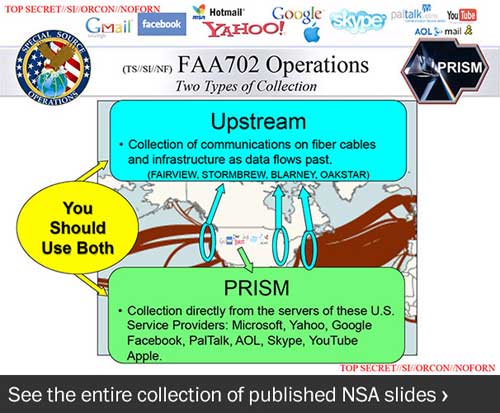当前位置: Language Tips> 双语新闻
U.S. Spies on Undersea Fiber Cables
 |
|
The Washington Post on Wednesday published a classified NSA slide that provided side-by-side guidance on the two surveillance programs. The Leaked NSA Slide Reveals PRISM’s Brother – Upstream. |
|
查看原文 "You Should Use Both," the slide said, in an apparent message to NSA personnel. At the bottom was a description of "PRISM," the previously reported program that collects data from the servers” of tech companies such as Google, Microsoft, Facebook, Yahoo, Skype, PalTalk, AOL, YouTube and Apple. Some of these tech companies have strongly denied being involved with the NSA's spying activities. PRISM — which could be considered “downstream” collection because the data is already processed by tech companies At the top was a blurb on "Upstream," which it described as "collection of communications on fiber cables and infrastructure as data flows past." The Post article suggested the latter was part of an effort to tap into the fiber-optic cables that contain gobs of voice and Internet data. Upstream lists "Fairview, Stormbrew, Blarney and Oakstar" as its sources. According to The Washington Post, Blarney gathers up metadata on the Internet as part of “an ongoing collection program that leverages IC [intelligence community] and commercial partnerships to gain access and exploit foreign intelligence obtained from global networks.” The slide contains a rough map of North America, showing the underseas cables fanning out from the West and East coasts of the United States, to the rest of the world. These undersea cables are essential to worldwide data flows – and to the surveillance capabilities of the U.S. government and its allies. Agreements with private companies protect U.S. access to cables’ data for surveillance This “Network Security Agreement,” signed in September 2003 by Global Crossing, became a model for other deals over the past decade as foreign investors increasingly acquired pieces of the world’s telecommunications infrastructure. The security agreement for Global Crossing, whose fiber-optic network connected 27 nations and four continents, required the company to have a “Network Operations Center” on U.S. soil that could be visited by government officials with 30 minutes of warning. Surveillance requests, meanwhile, had to be handled by U.S. citizens screened by the government and sworn to secrecy — in many cases prohibiting information from being shared even with the company’s executives and directors. |
美国《华盛顿邮报》7月10日爆料称,除了“棱镜”计划外,美国情报机构还有一个名为“上游”(Upstream)的监控项目,通过美国周边的海底光缆搜集情报。 ***棱镜有一个“哥哥” 这篇报道公布了一张美国国家安全局的机密幻灯片,其中对“棱镜”计划、以及与之平行展开的“上游”计划有所介绍。 在这一张最新公布的演示图中,上半部分蓝色框内是“上游”项目,是从“海底光缆等基础设施的收集数据”。图片下半部分绿色框内解释“棱镜”计划是通过谷歌、微软、脸谱、雅虎、Skype、PalTalk、Youtube、苹果、和美国在线等9家互联网企业挖掘数据。 “棱镜”计划相当于“下游”项目,因为收集的是经过科技公司加工的数据。 幻灯片还用黄色圆圈提醒国家安全局人员“应利用两个项目”。 这张幻灯片中使用的背景是一张粗略的北美地图,其中显示了从美国东西海岸延伸至世界各地的深海电缆路线。海底光缆对世界范围内的数据传播方面极为重要,对美国及其盟友的监控项目也有举足轻重的影响。 ***签署协议与电信公司合作 为保障“上游”项目的顺利实施,美国国家安全局和国防部等机构在2003年与美国环球电讯公司签署《网络安全协议》。在过去10年中,有更多的电讯公司签署了类似合作协议。 这项协议中规定,环球电讯公司需要在美国本土建立一个“网络运行中心”,美国政府官员可以在发出警告后的半小时内进入查访。据悉,环球电讯公司的海底光缆覆盖全球4个大洲的27个国家和地区。 今年6月初,美国中情局前职员爱德华•斯诺登揭露美国“棱镜”项目,称美国国家安全局等机构通过互联网企业监控民众互联网活动和通话记录。目前,美国因此遭到外界指责,滞留莫斯科机场的斯诺登的下一步去向也成为国际关心的话题。 相关阅读 (翻译:变色龙 编辑:Julie) |
上一篇 : 杨洁篪:中美可建立更加密切的合作关系
下一篇 : 韩亚空难重伤中国女学生身亡 遇难人数升至3人
关注和订阅

电话:8610-84883645
传真:8610-84883500
Email: languagetips@chinadaily.com.cn